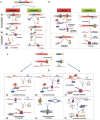Regulatory RNAs in the Less Studied Streptococcal Species: From Nomenclature to Identification
- PMID: 27507970
- PMCID: PMC4960207
- DOI: 10.3389/fmicb.2016.01161
Regulatory RNAs in the Less Studied Streptococcal Species: From Nomenclature to Identification
Abstract
Streptococcal species are Gram-positive bacteria involved in severe and invasive diseases in humans and animals. Although, this group includes different pathogenic species involved in life-threatening infections for humans, it also includes beneficial species, such as Streptococcus thermophilus, which is used in yogurt production. In bacteria virulence factors are controlled by various regulatory networks including regulatory RNAs. For clearness and to develop logical thinking, we start this review with a revision of regulatory RNAs nomenclature. Previous reviews are mostly dealing with Streptococcus pyogenes and Streptococcus pneumoniae regulatory RNAs. We especially focused our analysis on regulatory RNAs in Streptococcus agalactiae, Streptococcus mutans, Streptococcus thermophilus and other less studied Streptococcus species. Although, S. agalactiae RNome remains largely unknown, sRNAs (small RNAs) are supposed to mediate regulation during environmental adaptation and host infection. In the case of S. mutans, sRNAs are suggested to be involved in competence regulation, carbohydrate metabolism, and Toxin-Antitoxin systems. A new category of miRNA-size small RNAs (msRNAs) was also identified for the first time in this species. The analysis of S. thermophilus sRNome shows that many sRNAs are associated to the bacterial immune system known as CRISPR-Cas system. Only few of the other different Streptococcus species have been the subject of studies pointed toward the characterization of regulatory RNAs. Finally, understanding bacterial sRNome can constitute one step forward to the elaboration of new strategies in therapy such as substitution of antibiotics in the management of S. agalactiae neonatal infections, prevention of S. mutans dental caries or use of S. thermophilus CRISPR-Cas system in genome editing applications.
Keywords: Regulatory RNA nomenclature; Streptococcus agalactiae; Streptococcus mutans; Streptococcus thermophilus; non-coding RNA; small RNAs.
Figures

References
-
- Bartel D. P. (2004). MicroRNAs: genomics, biogenesis, mechanism, and function. Cell 116 281–297. - PubMed
Publication types
LinkOut - more resources
Full Text Sources
Other Literature Sources

